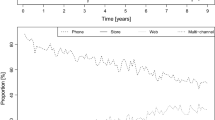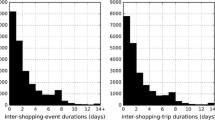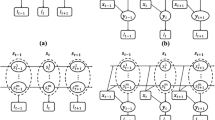Abstract
Due to technological developments, data about how many items a customer buys and how long the customer spends in a supermarket are available. A major problem with the data, however, is that there is no framework that considers the heterogeneity hidden in the data. In this article, we propose a framework that considers heterogeneity in the number of items a customer buys. The first step of our framework is based on the Poisson mixture regression model using a stationary time in the department where the items are sold as its independent variable. This model finds latent homogeneous groups of customers and gives the regression models within each group. It simultaneously classifies the customers into the homogeneous groups. In the second step of our framework, a method to investigate whether another factor (variable) influences the classification into homogeneous groups is presented. This proposed framework is applied to real data collected from the customers, and the effectiveness of the framework is shown. The managerial implications are drawn from the result of the analysis.


Similar content being viewed by others
References
Bozdogan, H. (1987). Model selection and Akaike’s Information Criterion (AIC): the general theory and its analytical extensions. Psychometrika, 52, 345–370.
Breiman, L., Friedman, J.H., Olshen, R.A., Stone, C.J. (1984). Classification and regression trees. Chapman and Hall.
Colonial Stores and Progressive Grocer (1963a). Colonial study introduction. In Progressive Grocer (pp. 37–44).
Colonial Stores and Progressive Grocer (1963b). Colonial study part I. In Progressive Grocer (pp. 38–70).
Colonial Stores and Progressive Grocer (1963c). Colonial study part II. In Progressive Grocer (pp. 36–68).
Colonial Stores and Progressive Grocer (1963d). Colonial study part III. In Progressive Grocer (pp. 37–45).
Colonial Stores and Progressive Grocer (1964a). Colonial study part IV. In Progressive Grocer (pp. 36–52).
Colonial Stores and Progressive Grocer (1964b). Colonial study part V. In Progressive Grocer (pp. 37–61).
Colonial Stores and Progressive Grocer (1964c). Colonial study part VI. In Progressive Grocer (pp. 37–53).
Dempster, A.P., Laird, N.M., Rubin, D.B. (1977). Maximum likelihood from incomplete data via the EM algorithm (with discussion). Journal of the Royal Statistical Society. Series B, 39, 1–38.
DeSarbo, W.S., & Grisaffe, D. (1998). Combinatorial optimization approaches to constrained market segmentation: an application to industrial market segmentation. Marketing Letters, 9(2), 115–134.
Dhar, R., & Nowlis, M. (1999). The effect of time pressure on consumer choice deferral. Journal of Consumer Research, 25, 369–384.
Fleiss, J.L., Levin, B., Paik, M.C. (2003). Statistical methods for rates and proportions. Wiley.
Grün, B., & Leisch, F. (2008). FlexMix Version 2: finite mixtures with concomitant variables and varying and constant parameters. Journal of Statistical Software, 28, 1–35.
Hui, S.K., Bradlow, E.T., Fader, P.S. (2009). Testing behavioral hypotheses using an integrated model of grocery store shopping path and purchase behavior. Journal of Consumer Research, 36, 478–493.
Jonker, J.-J., Piersma, N., Van den Poel, D. (2004). Joint optimization of customer segmentation and marketing policy to maximize long-term profitability. Expert Systems with Applications, 27, 159–168.
Kholod, M., Takai, K., Yada, K. (2011). Clockwise and anti-clockwise directions of customer orientation in a supermarket: evidence from RFID data. In Knowledge-based and intelligent information and engineering systems. Lecture Notes in Computer Science (LNCS) (Vol. 6883, pp. 304–309). Springer.
Konishi, S., & Kitagawa, G. (2010). Information criteria and statistical modeling. Springer.
Larson, J.S., Bradlow, E.T., Fader, P.S. (2005). An exploratory look at supermarket shopping paths. International Journal of Research in Marketing, 22, 395–414.
Little, R.J.A., & Rubin, D.B. (2002). Statistical analysis of missing data (2nd ed.). Wiley.
McLachlan, G., & Peel, D. (2000). Finite mixture models. Wiley.
R Development Core Team (2009). R: a language and environment for statistical computing. Vienna: R Foundation for Statistical Computing. ISBN 3-900051-07-0. URL: http://www.R-project.org.
Rosbergen, E., Pieters, R., Wedel, M. (1997). Visual attention to advertising: a segment-level analysis. The Journal of Consumer Research, 24, 305–314.
Sorensen, H. (2003). The science of shopping. Marketing Research, 15(3), 30–35.
Takai, K., & Kano, Y. (2012). Asymptotic inference with incomplete data. Communications in Statistics. Theory and Methods, to appear.
Takai, K., & Yada, K. (2010). Relation between stay-time and purchase probability with RFID data in a Japanese supermarket. In R. Setchi, I. Jordanov, R.J. Howlett, L.C. Jain (Eds.), Knowledge-based and intelligent information and engineering systems. Lecture Notes in Artificial Intelligence (LNAI) (Vol. 6278, pp. 254–263).
Takai, K., & Yada, K. (2011). Finding latent groups of customers via the Poisson regression model. In Proceedings of the 2011 IEEE international conference on system, man and cybernetics (pp. 3603–3608). IEEE Press.
Wang, P., Cockburn, I.M., Puterman, M.L. (1998). Analysis of patent data—a mixed-Poisson-regression-model approach. Journal of Business & Economic Statistics, 16, 17–41.
Wedel, M. (2002). Concomitant variables in finite mixture models. Statistica Neerlandica, 56, 362–375.
Wedel, M., & DeSarbo, W.S. (1995). A mixture likelihood approach for generalized linear models. Journal of Classification, 12, 21–55.
Wedel, M., DeSarbo, W.S., Bult, J.R., Ramaswamy, V. (1993). A latent class Poisson regression model for heterogeneous count data. Journal of Applied Econometrics, 8, 397–411.
Wedel, M., & Kamakura, W. (2000). Market segmentation (2nd ed.). Kluwer Academic.
Acknowledgements
The authors would like to thank two anonymous reviewers for their helpful comments to improve our manuscript. This work was supported by “Strategic Project to Support the Formation of Research Bases at Private Universities”: Matching Fund Subsidy from MEXT (Ministry of Education, Culture, Sports, Science and Technology), 2009–2013.
Author information
Authors and Affiliations
Corresponding author
Rights and permissions
About this article
Cite this article
Takai, K., Yada, K. A framework for analysis of the effect of time on shopping behavior. J Intell Inf Syst 41, 91–107 (2013). https://doi.org/10.1007/s10844-012-0223-6
Received:
Revised:
Accepted:
Published:
Issue Date:
DOI: https://doi.org/10.1007/s10844-012-0223-6




